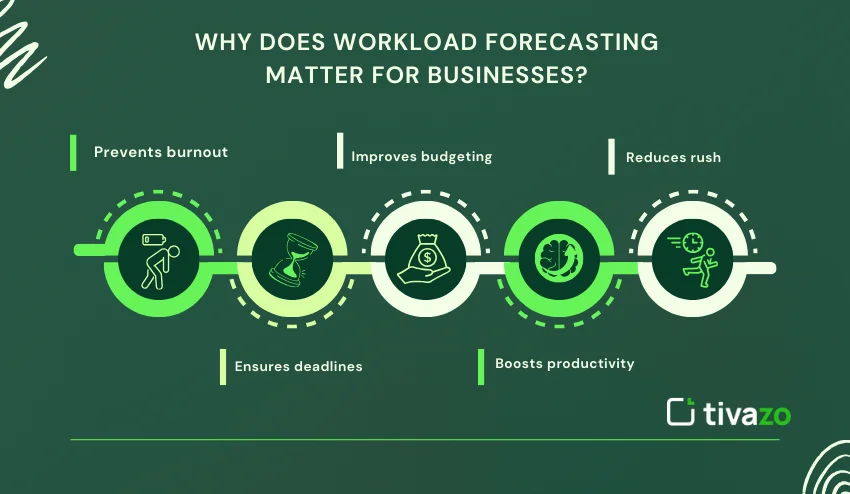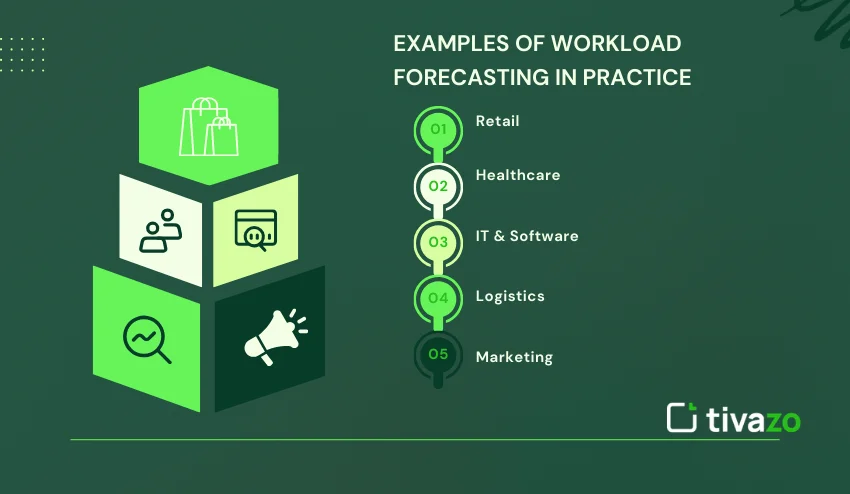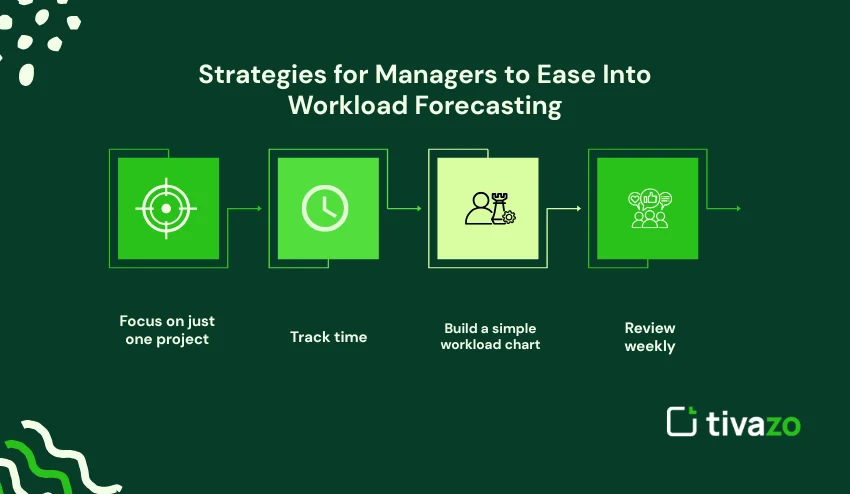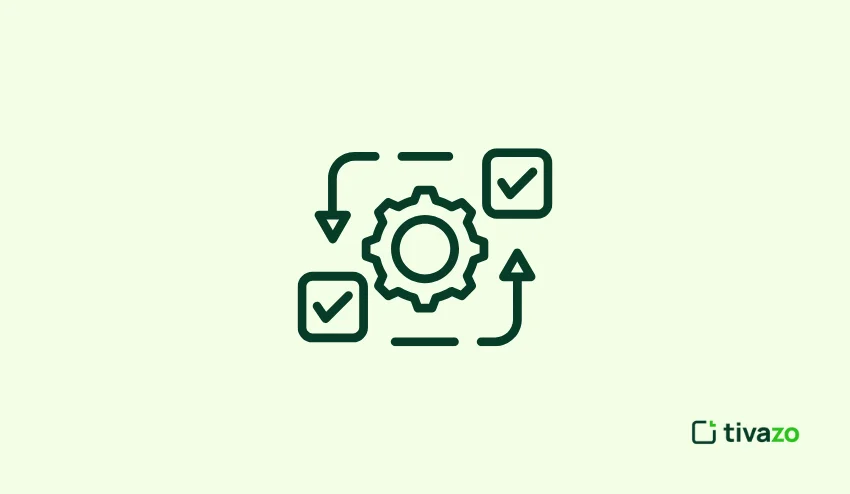Business leaders are regularly faced with the daunting task of managing deadlines, resource allocation, and employee health in a fast-paced environment. This is where workload forecasting comes in. By forecasting future workload demands, organizations can effectively deploy resources to support the work, lessen employee burnout due to excessive workload, and increase productivity across the organization.
In this blog post, we will explain what workload is and why it is important, how time tracking relates to workload forecasting, and practical, real-life options that you can implement immediately.
Regardless of the intent of your reading (informational: learning about workload forecasting, transactional: implementing it with your team, or navigational: seeking a specific workload forecasting system), this blog post gives you actionable feedback.
What is Workload Forecasting?
Workload forecasting refers to the act of estimating the workload needed to be done within a specific time frame. Managers can analyze data, historical trends, and team capacity in order to allocate resources and keep projects working within a timeline. A good workload forecasting practice will let your business prepare for busy times, find warning signs for bottlenecking, and provide shifts with ample notification for a foreseen project.
Why Does Workload Forecasting Matter for Businesses?
- Prevents employee burnout caused by task overload.
- Ensures deadlines are plausible.
- Easier project budget/ planning accuracy.
- Enhances productivity and morale for the team.
- Diminishes the last-minute rush to find resources.
While addressing these issues is already beneficial to any employer, workload forecasting will actually provide actionable insights to managers. It provides team members the ability to strategize regarding their tasks, putting the most impactful work at the forefront. And it lessens the likelihood of one employee carrying the load of a certain task(s), where your team members can help to share the load. Companies that utilize workload forecasting generally agree that it leads to a higher level of efficiency, collaboration, and increased client satisfaction.
Ultimately, as workloads are forecasted in their regular practice on a business basis, your business leads with a proactive as opposed to a reactive approach to workload management, providing organizations the opportunity to quell challenges and track on course with business growth.

What is Workload Forecasting?
Workload forecasting refers to the act of estimating the workload needed to be done within a specific time frame. Managers can analyze data, historical trends, and team capacity in order to allocate resources and keep projects working within a timeline. A good workload forecasting practice will let your business prepare for busy times, find warning signs for bottlenecking, and provide shifts with ample notification for a foreseen project.
Why Does Workload Forecasting Matter for Businesses?
- Prevents employee burnout caused by task overload.
- Ensures deadlines are plausible.
- Easier project budget/ planning accuracy.
- Enhances productivity and morale for the team.
- Diminishes the last-minute rush to find resources.
While addressing these issues is already beneficial to any employer, workload forecasting will actually provide actionable insights to managers. It provides team members the ability to strategize regarding their tasks, putting the most impactful work at the forefront. And it lessens the likelihood of one employee carrying the load of a certain task(s) where your team members can help to share the load.
Companies that utilize workload forecasting generally agree that it leads to a higher level of efficiency, collaboration, and increased client satisfaction. Ultimately, as workloads are forecasted in their regular practice on a business basis, your business leads with a proactive as opposed to a reactive approach to workload management, providing organizations the opportunity to quell challenges and track on course with business growth.
Examples of Workload Forecasting in Practice
Workload forecasting can be applied in all sectors and industries to help you optimize your resources and increase your efficiency.
1. Retail
Anticipating busy shopping seasons and staffing appropriately. Proper workload forecasting helps stores to avoid under-staffing or over-staffing the various sales positions, while also maximizing customer satisfaction.
2. Healthcare
Scheduling staff during flu season vs. non-flu season. Hospitals utilize forecasting to appropriately schedule nurses, doctors, and other support staff, while helping to stave off potential burnout, while still ensuring that their patients receive adequate and timely care.
3. IT & Software
Balancing developers’ tasks and assignments before launching products. Through workload forecasting, project managers can allocate assigns equally among their programmers based upon their designated tasks of coding, testing, and deployment, while still meeting the stringent deadlines without sacrificing quality.
4. Logistics
Planning for heavy and busy delivery schedules. Businesses value workload forecasting to estimate shipping costs during the delivery period, assign drivers to vehicles, and assist with the internal scheduling of warehouses in an effective manner.
5. Marketing
Predicting assignment workload during the holiday shopping season. Marketing teams utilize workload forecasting to delegate things such as content creation, management of advertising, and social media based on what they predict will increase in their campaigns.
Workload forecasting also allows businesses to combine actual data with real-time data in order to set alerts for their management to notice delays approaching in their organization, reallocate resources as necessary, and keep the productivity levels direct and consistent throughout all departments. Utilizing proper forecasting practices that teams employ can also help the team make good decisions, reduce stress, and have a better working environment.

Tools and Systems that Support Workload Forecasting
The most effective workload forecasting will happen when workload forecasting is used in conjunction with time tracking and project management tools that are reliable. Project management tools with accurate task duration data, team availability, and project progress will allow for accurate, usable workload forecasting.
| Tool | Unique Features | Best For |
| Tivazo | Automatic time tracking, project performance | Teams that work for multiple clients |
| Toggl Track | Project/task level time tracking and reports | Freelancers & small teams |
| Harvest | Budget tracking, invoicing management | Agencies & consultancies |
| Monday.com | Project workload visualizations, automation | Large teams |
| Asana | Task tracking, project, and progress tracking | Cross-functional teams |
By using these tools, managers can take historical time data, add real-time updates, and then they can begin to improve the accuracy of their workload forecasting. For example, Tivazo allows teams to see how much time was spent on past projects, which will feed into better workload forecasting for future projects.
Monday.com and Asana both have a visual dashboard that will allow teams to identify potential bottlenecks and shift resources as needed. Tools like these, integrated with the workload planning, will allow for data-driven workloads that reflect a team or project, improving the ability to forecast workloads and help avoid guesswork, while allowing teams to improve the ability to meet deadlines, while keeping productivity and morale intact.
Strategies for Managers to Ease Into Workload Forecasting
If workload forecasting is new and intimidating, the only important thing to do is to start small and gradually grow. Here are actionable options managers have when implementing workload forecasting:
- Focus on just one project – Focus solely on forecasting one campaign, client project, or workflow in just one department. Focusing on fewer tasks allows you to trial your forecasting and improve your process, while making it easy to avoid overcomplicating the trial. This first step will help develop the confidence required to realize your workload forecasting ability.
- Track time – Collect a record of time spent by the team on normal tasks. Time tracking will serve as the foundation for forecasting workload, because it helps make the comparison against the planning workload to develop realistic expectations of time. Often, time tracking can be achieved with a format as simple as a spreadsheet or a simple time tracking program.
- Build a simple workload chart – Consider categorizing tasks by type, difficulty, or urgency. A visual depiction of the team’s workload will help evaluate and confirm bottlenecked tasks or adjust workload assignments. As part of the workload forecasting, creating a chart will build clarity and transparency.
- Review weekly – Each week, compare booked work vs. actual work. Regularly reviewing the difference between planned load vs. actual will demonstrate differences in estimates, highlight any sort of inefficiencies, and ultimately shape your workload forecasting accuracy.
With reliable patterns and processes in place to inform your workload forecasts, start to expand over time to multiple projects, teams, or departments. Expanding not too quickly will keep your forecasting manageable and actionable.
By starting small, managers can incorporate workload forecasting without creating too much overwhelm for their teams. This enables them at least to be data-informed and make better resource allocation decisions without feeling like they are already overloading themselves with work. This evidence and knowledge-based methodology can lead to more advanced methodologies in the future. These generally structured forecasting practices can ultimately allow teams to experience greater workflow, balanced workloads, and higher productivity.

Forecasting Workload in Remote Teams
As remote working becomes more common, workload forecasting has never been more important. To effectively manage distributed teams, you need clarity of who is doing what and what the actual task duration is. Workload forecasting allows managers to delegate tasks more equally, see potential workload imbalances, and ensure team members are not overworked.
Tools that include time tracking and visualizing workloads are especially useful for remote teams. They provide real-time updates, we are able to see what is happening with a project, and can forecast future workloads, all while team members may be in their own time zones.
When a remote team uses workload forecasting, productivity increases, but so does communication and accountability. Teams can coordinate better, collaborate better, and keep morale up when they are not physically together.
Conclusion
Workload forecasting is not a fad. It’s a strategy that results in improved productivity, morale, and profitability. When time tracking is accurate, a business can reduce guesswork, plan better, and be more competitive.
No matter if you are starting small or you’re implementing sophisticated systems, you must be consistent. The more you track, analyze, and forecast, the more efficient the business will run.
As time progresses, good workload forecasting helps managers spot bottlenecks, allocate resources preemptively, and address the workload balance, all to keep teams motivated and projects on track. This proactive behavior leads to a more seamless workflow while minimizing stress and enabling growth and sustainability.




